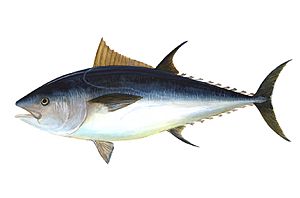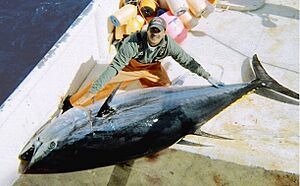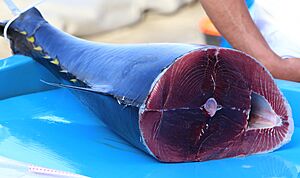Atlantic bluefin tuna facts for kids
Quick facts for kids Atlantic bluefin tuna |
|
|---|---|
 |
|
| Conservation status | |
| Scientific classification | |
| Genus: |
Thunnus
|
| Species: |
thynnus
|
| Synonyms | |
|
Scomber thynnus Linnaeus, 1758 |
|
The Atlantic bluefin tuna (Thunnus thynnus) is a very large and fast fish found in the ocean. It's a type of tuna and is sometimes called the northern bluefin tuna or giant bluefin tuna.
These amazing fish live in both the western and eastern parts of the Atlantic Ocean, as well as the Mediterranean Sea. Sadly, they are no longer found in the Black Sea. The Atlantic bluefin tuna is closely related to other bluefin tuna species, like the Pacific bluefin tuna and the southern bluefin tuna.
Atlantic bluefin tuna can grow to be huge, weighing up to 680 kilograms (about 1,500 pounds)! This makes them one of the biggest bony fish in the ocean, similar in size to large marlins and swordfish. For a long time, people have valued Atlantic bluefin tuna as a food fish. Besides being important for food, their incredible size, speed, and power make them admired by fishermen and scientists alike.
These tuna have been very important for one of the world's biggest fishing industries. Large and medium-sized bluefin tuna are especially sought after for the Japanese raw-fish market, where all bluefin species are highly prized for sushi and sashimi.
Because they are so popular, Atlantic bluefin tuna have faced serious overfishing. In 2009, experts reported that their numbers had dropped a lot over 40 years: by 72% in the Eastern Atlantic and 82% in the Western Atlantic. Many people and groups pushed for stronger protection. While a global ban on fishing was not approved, better rules have helped their populations grow a bit. As of 2021, the Atlantic bluefin tuna's status on the IUCN Red List of Threatened Species improved from "Endangered" to "Least Concern." However, many local groups of these fish are still in trouble, especially those in the western Atlantic that lay their eggs in the Gulf of Mexico.
Most bluefin tuna are caught by professional fishermen using long lines with many hooks, large nets called purse seines, or harpoons. For fun, bluefin tuna have been a top choice for sports fishermen since the 1930s, especially in the United States, Canada, Spain, France, and Italy.
Template:TOC limit=3
Contents
Understanding Bluefin Tuna
What is a Bluefin Tuna?
The Atlantic bluefin tuna was first described by a famous scientist named Carl Linnaeus in 1758. He gave it the scientific name Scomber thynnus.
This tuna is most closely related to the Pacific bluefin tuna and the southern bluefin tuna. It's also related to other large tuna species like the bigeye tuna and the yellowfin tuna. For many years, people thought the Pacific and Atlantic bluefin tuna were the same species, calling them "northern bluefin tuna."
In some languages, the name of the bluefin tuna includes the color red because of its meat, like atún rojo in Spanish or tonno rosso in Italian.
How to Spot an Atlantic Bluefin Tuna
The Atlantic bluefin tuna has a strong, sturdy body shaped a bit like a diamond. Its head is pointed, and its mouth is quite large. They are dark blue on top and gray underneath, with shiny gold spots on their bodies and bright yellow fins near their tail.
You can tell bluefin tuna apart from other tuna by their short pectoral fins (the fins on their sides). Their livers also have a special feature: they are covered in tiny blood vessels.
Fully grown adult bluefin tuna are usually about 2 to 2.5 meters (6.5 to 8 feet) long and weigh around 225 to 250 kilograms (500 to 550 pounds). The biggest one ever officially recorded was caught off Nova Scotia, Canada, and weighed 679 kilograms (1,497 pounds) and was 3.84 meters (12.6 feet) long! Some very old bluefin tuna can live up to 50 years.
Bluefin tuna are incredibly strong. They use powerful muscles connected to their crescent-shaped tail fin to push themselves through the water. Unlike many other fish, their body stays stiff while their tail moves back and forth, which makes them very efficient swimmers. They also have a super-efficient blood system that helps them get lots of oxygen to their muscles.
To keep their swimming muscles warm, Atlantic bluefin tuna have a special system that prevents heat from escaping into the cold water. This allows them to hunt for food even in the chilly waters of the North Atlantic.
Life in the Ocean
What Do Bluefin Tuna Eat?
Bluefin tuna can dive very deep, sometimes over 1,000 meters (3,300 feet)! They usually hunt smaller fish like sardines, herring, mackerel, and eels. They also eat creatures like squid and crustaceans (like crabs and shrimp). They often hunt in groups, chasing schools of fish. Their strong muscles help them swim very fast in short bursts to catch their prey.
Who Eats Bluefin Tuna?
When bluefin tuna are tiny babies, many other fish that eat small ocean creatures will prey on them. This greatly reduces their numbers. As they grow bigger, their predators also get bigger. Adult Atlantic bluefin tuna are only eaten by the very largest billfishes, toothed whales, and some large shark species that live in the open ocean.
How Bluefin Tuna Have Babies
Bluefin tuna lay eggs. They gather in large groups to spawn. Over several days, a female tuna releases millions of eggs into the water, where males fertilize them. A female can produce up to 40 million eggs at one time! The eggs hatch into tiny larvae just two days later. These larvae are only about a quarter-inch long after a week. About 40% of the larvae survive their first week, but only about 0.1% make it through their first year. The young tuna that survive tend to swim together in schools, grouped by size.
Atlantic bluefin tuna have two main places where they lay their eggs. One is in the western Mediterranean Sea, especially near the Balearic Islands. The other is in the Gulf of Mexico. Scientists believe that most bluefin tuna return to the area where they were born to lay their own eggs.
Because bluefin tuna gather in large groups to spawn, they are very easy for fishermen to catch during this time. This is especially true in the Mediterranean, where planes can spot the groups of spawning tuna from the air, guiding fishing boats to them.
In recent years, researchers have suggested there might be a third spawning area in the Slope Sea, which is north and west of the United States coast.
Bluefin Tuna and People
Fishing for Bluefin Tuna

After World War II, Japanese fishermen started using long lines with thousands of hooks to catch more tuna. In the 1970s, new technology allowed them to freeze tuna at sea, so they could bring fresh-quality fish to market even after a year.
Before the 1960s, Atlantic bluefin fishing was smaller, and their populations were stable. But in the 1960s, large fishing boats called purse seiners caught huge numbers of young bluefin tuna in U.S. waters, removing many entire age groups of fish. Fishing in the Mediterranean has also been hard to control, with many countries competing for fewer fish. Because bluefin tuna travel across many different countries' waters and the open ocean, it's difficult to manage their fishing.
Raising Bluefin Tuna on Farms
Tuna farming, also called "tuna ranching," started in the 1970s. Fishermen catch young bluefin tuna and raise them in pens until they are much larger. These farmed tuna can then be sold for high prices, especially in Japan. This helps provide a steady supply of tuna, as catching them in the wild can be unpredictable.
However, tuna farming can also be a problem. Many young tuna are caught from the wild before they are old enough to have babies themselves. This is one of the biggest threats to the species. Bluefin tuna also grow slowly and have babies later in life, which makes their problems worse. The Atlantic bluefin population has dropped by almost 90% since the 1970s.
Scientists in Europe and Australia are working on ways to get bluefin tuna to lay eggs in captivity, using special lights and hormones. This could help reduce the need to catch young tuna from the wild.
One challenge with farming bluefin tuna is that they need a lot of food to grow – up to 10 times more than salmon. If bluefin tuna were farmed on the same huge scale as salmon, many of the smaller fish they eat might become overfished themselves.
Dangers to Bluefin Tuna
The biggest threat to Atlantic bluefin tuna is the global demand for them as food. Even with warnings about their declining numbers, too many are still being caught. Tuna farming, while trying to help, still often relies on catching young wild tuna instead of breeding them in captivity.
In 2010, a huge oil spill called the Deepwater Horizon oil spill happened in the Gulf of Mexico. This was during the time when Atlantic bluefin tuna lay their eggs. The oil covered a vast area, including a lot of the tuna's habitat. This spill likely affected the eggs and baby tuna, though it's hard to know the full long-term impact. Scientists have seen problems like heart issues in tuna exposed to the oil.
Protecting Bluefin Tuna
Organizations Helping Tuna
The International Commission for the Conservation of Atlantic Tunas (ICCAT) is an organization that sets rules for Atlantic bluefin fishing. In 2007, their scientists suggested a limit of 15,000 tonnes of tuna to be caught each year to keep populations stable, or 10,000 tonnes to help them recover. However, ICCAT initially set a much higher limit. Later, they reduced the limit, and their scientists now say that 7,500 tonnes is the safe limit. In 2009, ICCAT set the 2010 limit at 13,500 tonnes.
In 2010, the United Nations decided not to completely ban Atlantic bluefin tuna fishing and trade. Japan, a major opponent of the ban, argued that ICCAT was the right group to manage the fishing.
In 2011, the USA's National Oceanic and Atmospheric Administration (NOAA) decided not to list the Atlantic bluefin tuna as an endangered species. They believed that the new international fishing rules would be enough for the tuna to recover. NOAA agreed to look at the species' status again later.
In 2012, countries meeting in Morocco voted to keep strict fishing limits because the tuna population was still fragile. The limit increased only slightly. Later, in 2014, the limits were raised a bit more as the populations showed some improvement.
In 2020, the UK government noticed more bluefin tuna in their waters and started funding research to understand them better and plan how to manage them.
Other Groups Working for Tuna
In 2010, Greenpeace International added the northern bluefin tuna to its "seafood red list," meaning it's a species to avoid eating. It remains on this list.
In 2011, the Sea Shepherd Conservation Society worked to stop what they believed was illegal bluefin tuna fishing off the coast of Libya.
Some food critics have also spoken out against restaurants serving bluefin tuna, arguing that it puts the species at too much risk.
The Monterey Bay Aquarium also lists bluefin tuna on its Seafood Watch list as a fish to avoid because of overfishing.
Bluefin Tuna as Food
Atlantic bluefin tuna is one of the most highly valued fish used in Japanese raw fish dishes. About 80% of all Atlantic and Pacific bluefin tuna caught are eaten in Japan. Bluefin tuna sashimi is a special treat in Japan. For example, an Atlantic bluefin tuna caught off the eastern United States sold for US$247,000 at a fish market in Tokyo in 2008.
Japanese people started eating tuna sushi in the 1840s. Back then, red-fleshed fish like tuna were not as popular as white fish because they spoiled quickly. But over time, with better refrigeration, tuna sushi became very common in Japan by the 1930s.
See also
- Natal homing
- Guillaume Fourrier
Images for kids





